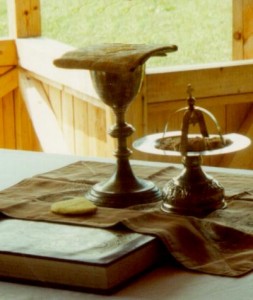| Eucharist
or "communion" in the body and blood of Jesus Christ. |
 |
|
Bread
and wine
|
In his last supper
with his disciples, Jesus took bread and offered it to his disciples as
his body and gave them wine from a cup as his blood. The Apostle Paul
calls this a proclamation of the Lord's death (1 Cor. 11:26) and taught
that when Christians partake of this it is a "communion" in the body and
blood of Christ (1 Cor. 10:16-17). Little is certainly known of how the
earliest Christians enacted this observance, although patterns seem to
have varied widely. There is, for example, no indication in the New Testament
that the administration of this meal was associated with any fixed offices.
The concept of sacrifice was early associated with this rite. Irenaeus
speaks of Christians offering bread and wine, but does not speak of an
offering of Christ to the Father. Cyprian
in the third century thinks of this rite as including an offering of the
body and blood of Christ as sacrificial gifts to the Father. Christians
also early regarded this rite as primarily a eucharist, a giving of thanks.
This is evident, for example, in the Didache.
In the earliest centuries some teachers, including Clement of Alexandria
and Origen, were inclined toward a
symbolic view of Christ's presence in the elements of bread and wine.
Others, including Ignatius of Antioch
and Justin Martyr, thought of Christ's
presence in more physical terms. As early as the time of Tertullian
in the third century, Christians referred to this rite as a "sacrament."
|